Chris & Allyson vs. Alaska (2016)
Chapter Four: Juneau.
Juneau is the capital of Alaska, and it stands to reason that a majestic state would have a majestic capitol. Maybe something that looks like the Fortress of Solitude. I am a civics nerd, so it was my duty to visit that capitol.
Part of being a civics nerd is recognizing that it's a lonely pursuit, so I started the sixth day of our vacation well before my wife. The ship had docked in Juneau overnight. I was off the ship a few hours before most of the other passengers, and before most of the people who work in downtown Juneau got to their jobs. You wouldn't expect traffic in a city of 32,000 people connected to no other cities by road. But it was eerily like a movie studio back lot.
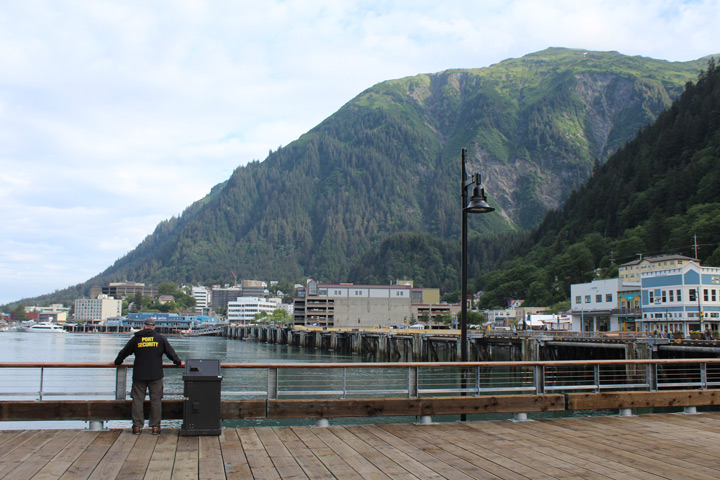
Welcome to Juneau! Isolated and beautiful.
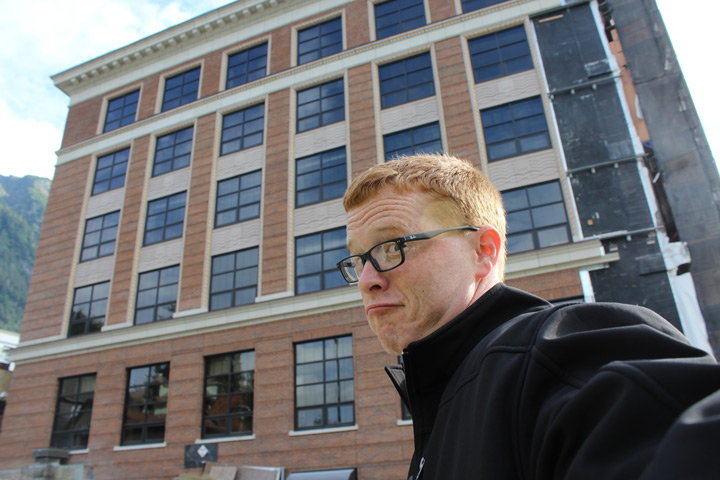
I wanted to visit the Alaska capitol. Fate had other ideas.
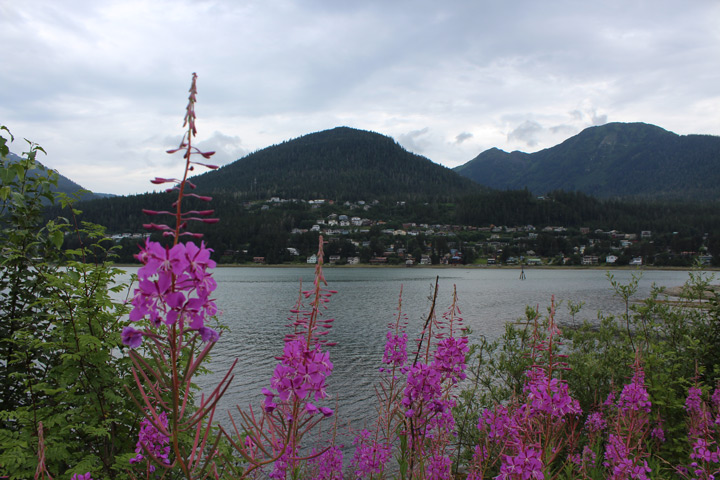
Fireweed and water ... about as Alaskan as you can get.
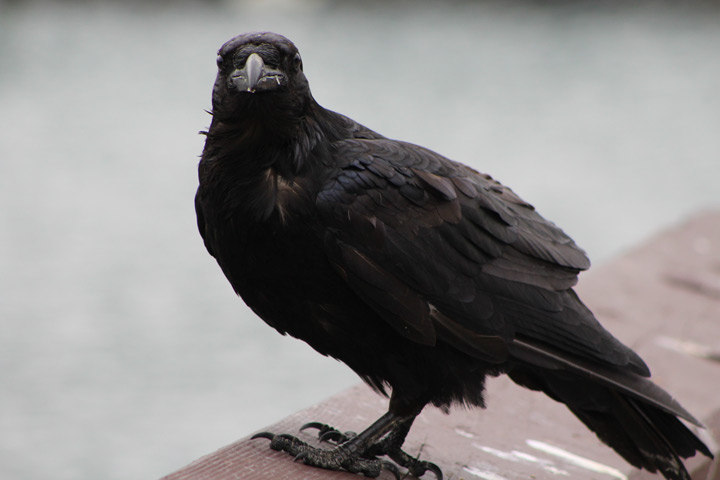
On the Juneau waterfront, one of Alaska's most iconic birds.
I personally love the emptiness, and Juneau is a fantastic city to wander around. The cruise dock is right downtown, but you can't go more than a few blocks inland before the climbing begins. The heart of Juneau is flanked by Mount Juneau and Mount Roberts. By Alaskan standards, they aren't the biggest mountains. But you could see snow on the top of Mount Juneau, and there are public binoculars on the dock to help you spot goats on the side of the mountain. Nature hangs over the city at every turn.
The businesses and homes of Juneau look quaint, or quirky, or whatever q-word you prefer. Hoofing it up a residential strip, I walked past modernist dwellings and a few places built in the gingerbread style. The streets are steep enough that every home probably has a great view of the water.
Of course, this was a hard-target search, and after a few minutes of walking I found the capitol. It did not look like the Fortress of Solitude. It looked like a big rectangular building that was heavily under construction. Yes, the capitol was closed for renovations, with no chance of sneaking inside to see the interior. This was a mild bummer for me, as you hear many so many stories of the legendary Alaskan legislature, America's most valued crucible of democracy. Fortunately, I don't have the hobby of visiting every state capitol. (Yet.) Alaska is one of the toughest "gets," and I imagine those people had Wally World reactions, all summer long.
I wanted to do SOME learning, so I popped next door to the Juneau-Douglas Museum, where I could gather information to assault my wife with all day long. It's a small space, but heavy on the information, and here's what I remember:
Juneau is a mining town. People flooded the region in search of gold in the 1880s, and it quickly turned from a humble DIY operation into an industrial marvel. Juneau (and Douglas, just across the channel) became home to "stamp mills," which were essentially rock-crushing factories. Miners would remove parts of a mountain and run them through the smashing machines. The dust and rubble was sifted on a huge scale to separate the gold. This was all necessary, because while there was gold in Juneau, it wasn't laying around in giant nuggets on the ground, the way most imbeciles hoped.
The mines were very profitable, until they weren't. One of them flooded in the early 1900s, and the last of them closed in World War II. Fortunately, Juneau had a backup plan. In 1906, when the city was still the economic powerhouse of Alaska, the territorial government was moved there. As Alaska grew, this was a decision that more and more people came to regret. Juneau is very far from Anchorage and Fairbanks, the other major population centers. By the time some legislators got to Juneau to vote, their terms had already ended and they'd been voted out of office for missing all those workdays. For most of the last century, Juneau has waged a perpetual PR campaign to keep its capital status. Why? Because tax dollars are a natural resource you can't exhaust.
Loaded with a brain-numbing amount of information, I made my way back to the dock, with a quick stop to photograph a group of ravens. You'll take a lot of eagle photos in Alaska, but ravens are just as important to the cultural heritage of the state. The Tlingit have a wealth of stories where the Creator is named Raven, and can assume bird form. So if you see the creator of the universe eating out of a garbage can in downtown Juneau, maybe take a few pictures out of respect.
As exciting as these last few paragraphs have been for the reader, our day in Juneau promised to be the most exciting day of our trip. At least, if you measure excitement by how much money you're spending. The lovely Allyson joined me near the dock, and we waited in a light drizzle for the day's excursion. We were going to ride in a helicopter. And on a dog sled. And on a glacier.
But first we had to ride in a van. The tour company rounded us up, and by "us" I mean me, Allyson, and a mom from Atlanta with her son and daughter. The van driver was a teenage Juneau native who filled us in on local life. Because the city is accessible only by boat or air, there's a real sense of community; it's like Petticoat Junction but with more bears. Also, if you're a high school athlete, you REALLY have to commit, because you're taking overnight ferries any time you have an away game. It seems ridiculous that no one has made a coming-of-age comedy about an Alaskan high-school basketball team on their last away game of the season. Get on it, Hollywood.
Unexpectedly, the van ride dispelled our romance with bald eagles. When you get to Alaska, eagles are breathtaking and majestic. After seeing at least one eagle a day for four days, they are downgraded in your mind to "neat" and "maybe not as endangered as I thought." The ride to the heliport took us away from downtown, along the Mendenhall Wetlands. At high tide, the water level rises so much that the entire area is submerged. When the tide goes out, all the fish that strayed from the main channel are trapped in shallow, muddy pools. If you thought eagles were glorious and proud creatures, maybe watch 10 of them lined up at a puddle like it was an Old Country Buffet.
Seeing eagles act like pigs didn't diminish the excitement of our own impending flight. Both Allyson and I have a touch history with helicopters, going back to Hawaii. As children, each of us enjoyed a family vacation to Hawaii, and each of us experienced a sightseeing tour through choppy skies resulting in family-wide puking. If that happens once in your early years, you get a little skittish about small aircraft, especially when you're the adult paying for the helicopter ride.
Fortunately, Raven was smiling upon us. We piled into a small helicopter -- the five of us, plus Sebastian Schnuelle, the dog musher in charge of the camp where we were headed. (Sebastian is the real deal, having finished second in the Iditarod. I'd like to tell you that he regaled us with tales of missing toes and forbidden romance with a yeti, but all we got was a few quips. He was just bumming a ride up the mountain.) Liftoff was smooth, we pulled away from the airport, and the sightseeing began.
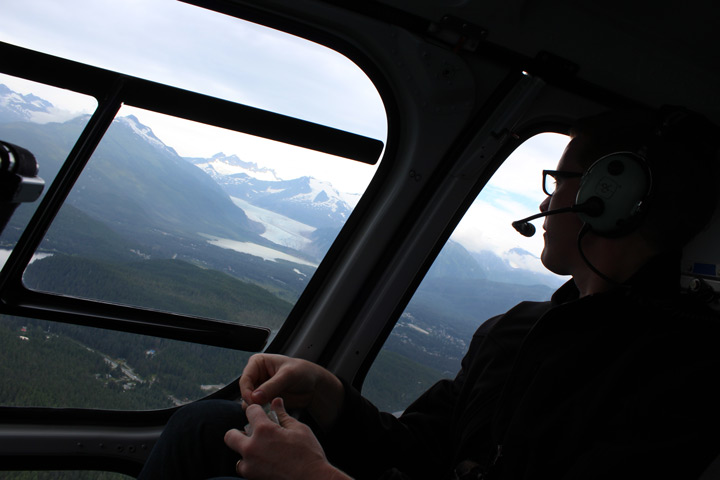
En route to the Herbert Glacier.
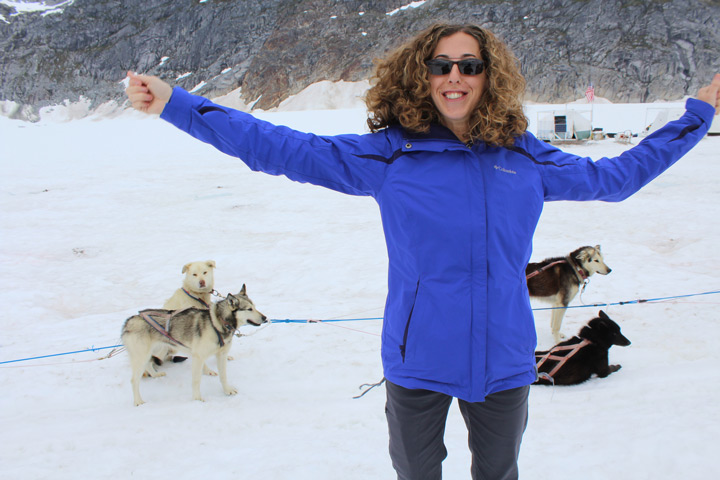
Back on the ground at Herbert Glacier and ready to mush!
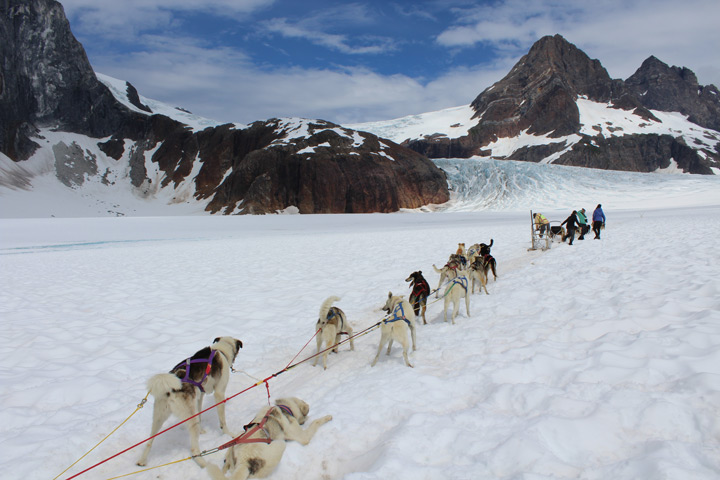
A dogsledding adventure in the mountains above Juneau.
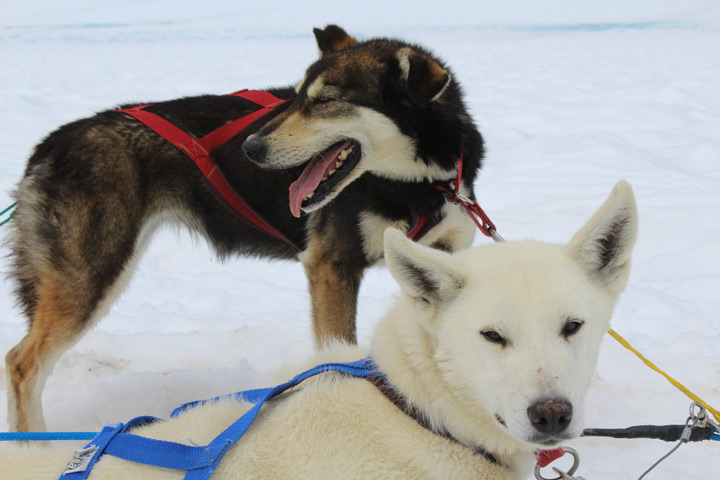
Our gracious hosts for our afternoon in Alaska's capital.
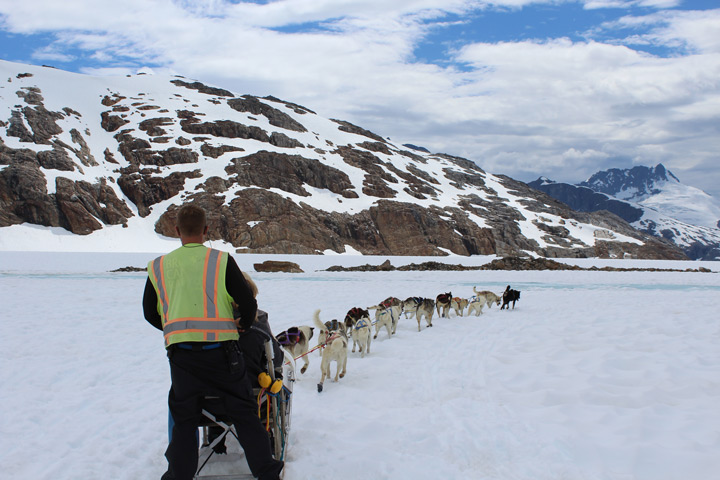
The view from the trailing sled. Our guide is shown on the lead sled.
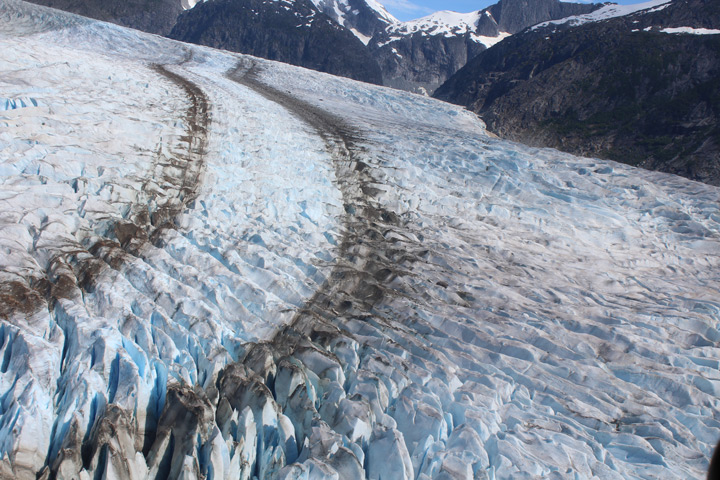
From the helicopter, a view of a "road" created by glacial movements.
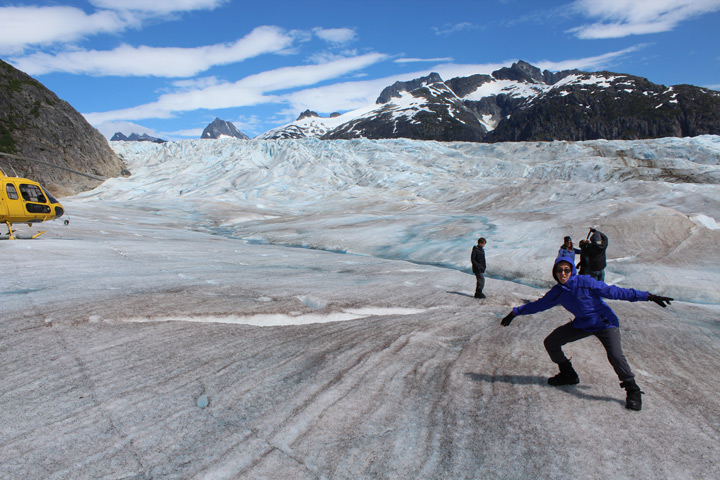
Checking out some of the geologic highlights on Herbert Glacier.
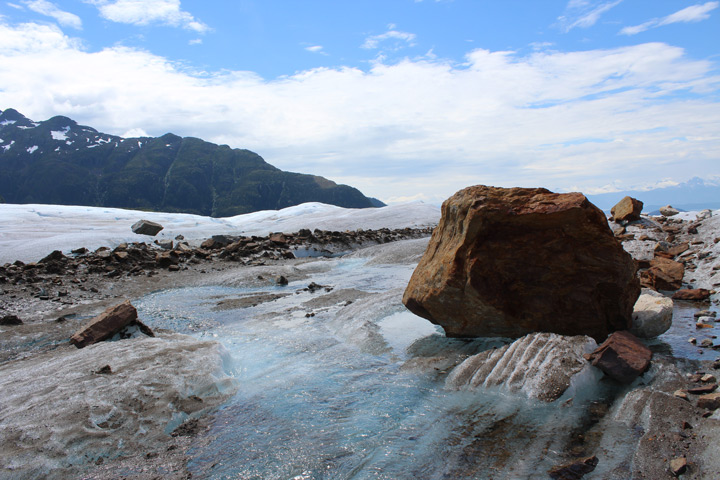
A glacial landscape, high above Juneau.
So, what exactly are these glaciers we've been hearing so much about? The most elegant description I've seen is "a river of ice." Snow falls on a mountain, where temperatures are so cold it does not melt. It is packed down by more snow, and more snow, and more snow, and more snow after that. The weight of the snow on top compresses the snow below into a dense block of ice; in some cases the ice is so dense that it appears to be blue. The ice grows into a huge mass, sometimes covering an entire valley, sometimes "hanging" from a higher peak. All that mass is constantly pulled by gravity, so the ice "flows" downhill, crushing and grinding the ground beneath. As temperatures change over the centuries, glaciers advance and retreat, carving U-shaped landscapes. The ice warps into formations that can resemble flowing water or dramatically jagged rocks. Glaciers hold a huge amount of the world's fresh water, and at any given time they also hold 53 percent of the tourists in Alaska.
As all of Alaska's glaciers have been shrinking in recent decades -- it's a well-documented fact -- it might be best to see them while you can.
In Juneau, the trendy glacier is the Mendenhall. It's in a valley, hanging over a very nice lake that is a very short distance from downtown. The "toe" of the glacier (the exposed end on the downhill side) is a brilliant blue wall of ice, and you can hike pretty close to that wall if you like. Cruise ship companies like it because it's extremely convenient.
But if you’re willing to pay a few hundred dollars for a helicopter ride, screw convenience. We did see the Mendenhall Glacier – from the window of our helicopter, as we sped toward the Herbert Glacier a few valleys over. The helicopter pilot, a guy from Idaho, flew us straight over the Herbert's toe and did some cool banking turns to give everyone a view of the glacial formations. We saw huge crevasses in the ice field that might have been hundreds of feet deep. From above you could see the medial moraine, a trail of boulders and rocks that had been herded to the middle of the valley by the flowing ice. Above the clouds, we could see a few smaller glaciers hanging on to the rugged ridgelines and peaks of the mountains.
And then, to give us perspective, our pilot pointed out some small rectangles in the distance. It was the sled dog camp, and seeing it from the chopper was a little bit mind-blowing. The nature in Alaska is enormous, and viewed from afar -- even from a helicopter -- it can be tough to get any sense of scale. You can't appreciate how big the trees are until you're standing next to a trunk. You can't appreciate the size and sweep of a mountain or glacier until you see something man-made for reference. We were impressed by all the landscape we were seeing. But when we spotted the dog camp, we became amazingly impressed.
As an added bonus, we were about to meet the dogs! Planning our Alaska trip, Allyson and I were able to pick the brains of both sets of parents, as both had been to Alaska before. Allyson's dad loved the chance to dog sled, because he loves anything involving animals. This was genetically passed on to my wife. Although she is allergic to dogs, she still seemed excited to hang out with them.
Our guide at the camp was Kenny, a former Marine from Ohio. Before we got to sledding, he told us about life at the camp. The dogs spend their summer slogging cruise ship patrons around, but it actually does serve as training for big-time races such as the Iditarod and the Yukon Quest. It helps them build endurance and teamwork. There were 61 dogs in the camp, all roughly under the category of "Alaskan husky" -- a wolf-like mutt. The dog mushers spend six days on the mountain at a time, with one day in town to do laundry or catch a movie or whatever. The mushers sleep in tents, often in bitter cold conditions at night. The dogs have to mush on snow (not ice), so every few weeks the camp has to move as warmer summer temperatures wipe out the thinner patches of snow resting on top of the actual glacier. Once too much snow has melted (usually in August), they're done for the season.
Also, the dog sledding area is part of the Tongass National Forest, so there are strict federal policies about what commercial enterprises can leave behind. Meaning, it is the solemn duty of the dog mushers to retrieve every piece of dog poop from all 61 dogs. And they say there are no good jobs left for young people.
It's not quite right to say that we "mushed." It's more accurate to say that "the dogs dragged our dead-weight asses around the mountain." There was a sled for Kenny, from which he gave commands to the dogs. The actual musher stands on the rails of the sled, while passengers sit in the sled's seats. A second sled was towed at the back, allowing for another seated passenger, and a passenger who gets to pretend that they're mushing by standing on the rails of that sled. (You do get to use a foot brake when Kenny tells you to, but that really just makes you into another mushee.)
It was still great fun. Allyson sat in front of Kenny for the first leg of the journey, and with our camera in hand she had a world-class view of the dogs pooping as they ran. Every few minutes, the dogs rested, we asked Kenny questions, and we rotated positions on the sleds. Everyone got to fake mush, including Allyson. She was worried that the pull of the dogs on the lines might yank her spine into exciting new positions, but she took the chance and did just fine. In fact, the only person truly injured was me. It was sunny, and the light was reflecting off the snow. So I got a mild sunburn. In Alaska, on a glacier.
A quick but memorable loop brought us back to the kennel, and a few minutes later captain Idaho returned with the helicopter for the second part of our trip. Some people paid only for the dog sledding. We know how to vacation, so we ponied up for a second glacier landing. After a nice low flight a few miles down the mountain, we landed directly on the ice field for the chance to walk around.
Remember how our parents had given us a preview of Alaska? This was the part of the excursion that my father described as "boring."
My dad must have landed on the wrong glacier, because the Herbert was awesome. The ice underfoot was crunchy, jagged and hard. (We were equipped with special shoes to grip the surface.) Melt streams and pools were spread around the landscape, as were big boulders slowly moved there over time. Some of the ice had a dirty appearance from wind-blown soil, but there were also hints of the brilliant glacial blue that comes from compressed ice. We had only a few minutes to wander around, but our group was all alone. It was like being on an alien landscape.
The pilot showed us a few ice features, the most notable being a "moulin." As glacial ice melts in the sun, it needs to drain somewhere. Sometimes it generates a tunnel straight down through the glacial mass to the rock below. Then it squirts out underneath the glacier at some point far down the mountain. The moulin tunnels might look harmless, but they can be hundreds of feet straight down; we were warned that anyone falling into the hole would disappear and never be seen again. It would be the worst water slide, ever. This naturally made the young boy from Atlanta very curious to stand near the edge and look down the hole.
We did "glacier push-ups," whereby you lay on your stomach to drink glacier water straight from a stream. Supposedly this is as clean and pure as water can get, and you can taste the complete lack of flavor.
After 20 minutes it was time to go. We piled back into the helicopter, which returned us to the airport. From there, a van took us back to the dock. This was by far the most expensive part of our trip, and we both agreed that it was totally worth it. But it did NOT fill our day. The van dropped us off around 1 p.m., with a lot of hours left before the Millennium left port. We needed something to do, so we took the path of least resistance and climbed 1,800 feet.
The Mount Roberts Tramway is another fine example of Native Alaskan entrepreneurship. Like Icy Strait Point, it's an attraction owned and operated by a native corporation. For 20 years, it has allowed people to get from the cruise dock to one of the most scenic views in Southeast Alaska, within minutes. Many people come to Alaska to see nature, but they will spend a lot of money to avoid walking through it for more than five minutes, so business is booming.
We bought our tickets at a mildly silly price, and within five minutes we were at the top. Five minutes after that, we were sitting down to lunch, because we were very hungry, and you wouldn't like Allyson when she's hungry. The extremely smart natives built a restaurant in the tramway terminal, overlooking Juneau and the Gastineau Channel. I had a bison/reindeer burger and an Alaskan Summer beer while taking in the view. And it was Alaska, so a few eagles flew past for good measure. After lunch, we walked the nature trail at the top of Mount Roberts. It was a short loop through some Alaskan shrubbery. Then we decided to make our way back to the ship on foot.
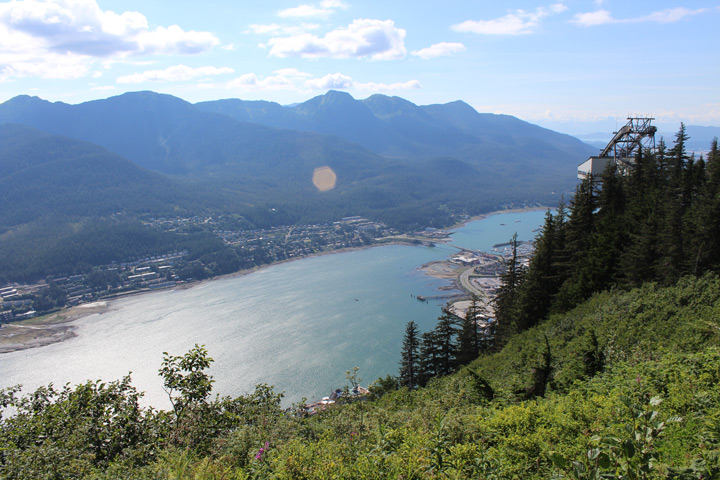
The amazing view from Mount Roberts, after riding up on the tramway.
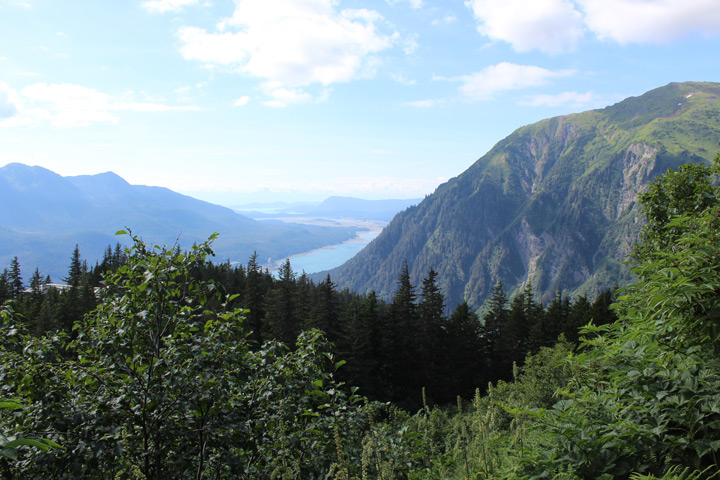
Another stunning view from the top of Mount Roberts.
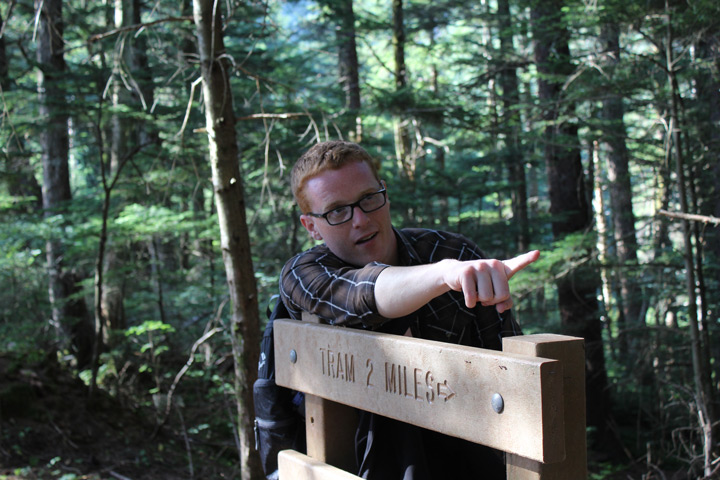
Blazing our path back to downtown Juneau. Mount Roberts.
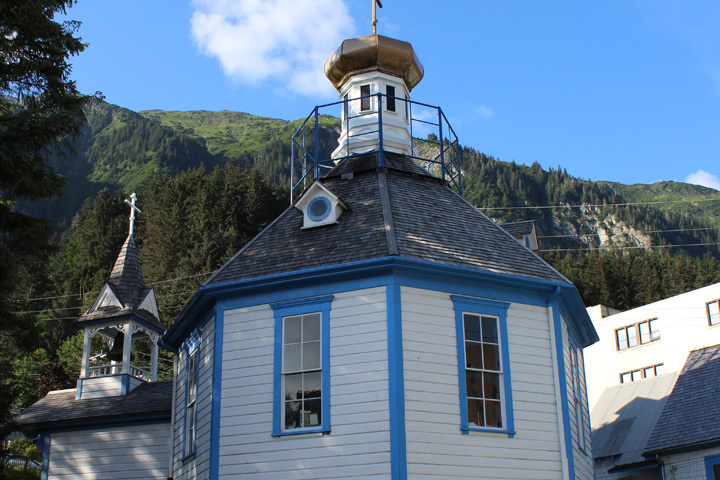
St. Nicholas church, a cute Orthodox joint.
The Mount Roberts summit trail would be brutal going up -- we passed a few people who, by the looks of them, had made a terrible mistake. But it was pleasant going down. We experienced a coastal Alaskan forest with big trees, big ferns, and a handful of ambitious dog walkers. The trail was well maintained, and every few minutes there was a break in the trees giving another fine view of the water. Allyson has a complicated relationship with hiking, but this was a positive experience. As we walked downhill we mostly talked about the fun we were having on vacation, and the bad decisions of the people going uphill, instead of any crippling pain that she was feeling. The trail dumped us into the neighborhoods of Juneau, giving me the chance to show off everything I learned on my solo excursion that morning.
Picking our way through the streets, we came across an old wooden church with that distinctive onion-dome Eastern European look. Alaska was Russian before it was American, and the Russian Orthodox faith is probably the most noteworthy reminder. To this day, there are Russian Orthodox churches working hard to convert Native Alaskans or sustain the congregations they already established. Those churches are among the oldest buildings in Alaska, and they have enough charm (hey, they're tiny and hexagonal!) that pedestrian tourists might walk in from the street.
St. Nicholas church has been around for 120 years, so we decided to poke our noses inside. That led to an interesting conversation with Father David, the priest waiting within. These situations can be a little tense, as both Allyson and I were expecting the hard sell. I'm a non-practicing Catholic, she's a non-practicing Jew, and this guy had only a few minutes to convert us to Russian Orthodoxy.
It wasn't quite like that. Instead, we found out that his daughter lives in Washington, only a few blocks from where we live, and that he enjoyed visiting our city. He told us a little backstory on some of the iconography, gave us a souvenir coffee mug and sent us on our way. There might be mind-control agents laced into the ceramic of the mug that will release over the course of time, but for the time being we're considering it a completely benign experience. Allyson escaped with her Judaism intact.
The last notable stop was at the Alaskan Brewing Company store, where there was less religion and more souvenir magnets. Usually stores aren't worth mentioning, but there's a nice story to be told with the beers of the Last Frontier. Alaska has a fun craft beer industry. I am not the world's finest judge of beer quality, but I do drink a lot of beer, and nothing I had in Alaska was bad. Alaskan Brewing was the brand of choice on the Millennium, and the easiest to find of all the state's brands. And there's actually a mining tie-in. When Juneau-based Alaskan Brewing was founded in the 1980s, they decided to use brewing techniques developed during the gold rush, when some conventional ingredients couldn't be obtained in the great white north. The resulting beers are distinctive, without tasting like they were mined.
I had a few of them with dinner that night, which might explain why I took no notes on anything that happened on board the ship.
